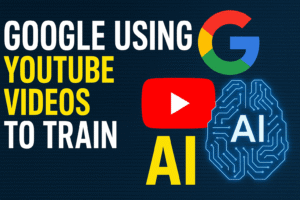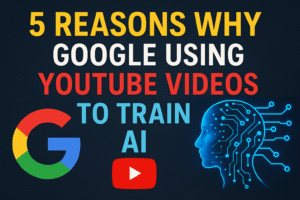5 Reasons Why Google Using YouTube Videos to Train AI Could Be Harmful to Creators

The news that Google is using YouTube videos to train AI models has raised alarm bells among content creators. With AI becoming an increasingly vital part of the digital landscape, Google’s move to leverage YouTube’s massive content library has significant implications. In this article, we will explore five key reasons why Google using YouTube videos to train AI could be harmful to creators and their rights.
How Google Is Using YouTube Videos to Train AI
Google has made significant strides in utilizing YouTube content to improve its AI models. By using videos to train AI algorithms, Google can enhance various features like content recommendations, video generation, and even speech recognition. But Google using YouTube videos to train AI comes with potential risks for the creators whose content is used for this purpose without their explicit consent.
-
Training AI for Better Recommendations: By training on YouTube’s massive database of videos, Google’s AI can improve its ability to recommend content to users, leading to better user engagement.
-
AI-Generated Content: AI systems like Gemini and Veo 3, which rely on YouTube videos for training, are designed to generate new content, from video editing to complete video creation, based on the data they learn from.
-
Speech and Text Understanding: Google’s AI models benefit from understanding the visual and auditory elements in YouTube videos, which can be applied to speech recognition and transcription features.
5 Reasons Why Google Using YouTube Videos to Train AI Could Harm Creators

1. Loss of Control Over Content
When Google uses YouTube videos to train AI, it’s possible that creators may lose control over how their content is used. While YouTube’s terms of service grant Google the right to use uploaded videos for various purposes, including AI training, many creators were unaware of the full extent to which their work would be utilized.
This lack of transparency raises concerns about ownership. Creators might feel that their work is being exploited without proper compensation or recognition.
2. Lack of Compensation for Creators
One of the major drawbacks of Google using YouTube videos to train AI is the lack of compensation for the creators whose videos are used. While Google benefits from the data, content creators receive no direct financial compensation for their work being used to enhance the AI’s capabilities.
Creators are the ones who generate content, yet they may see no reward from this use of their intellectual property. This highlights the need for better systems to compensate creators fairly for the use of their videos in AI training.
To learn more about YouTube’s policies regarding content usage, refer to YouTube’s Terms of Service.
3. Increased Risk of Misuse of Content
The Google using YouTube videos to train AI process could lead to the misuse of content. Once AI models are trained on videos, they can generate new content based on the data, potentially reproducing parts of the original content. This opens up the possibility of AI-generated videos being used without proper attribution or consent, violating intellectual property rights.
Creators might find their content replicated or edited without their permission, and without any control over how their work is used or shared.
4. AI Models May Alter Content Beyond Recognition
AI systems trained on YouTube videos might alter the content in ways that creators do not intend. For example, AI may remix, edit, or even take key parts of a video and use it in new, automated content creation. These AI-generated videos could be seen as derivatives of the original work, but creators may not have a say in how their content is reinterpreted by AI.
This raises concerns for content ownership and the potential for AI to replace the creative work of human creators with minimal oversight.
5. Potential for Reduced Viewer Engagement
If Google using YouTube videos to train AI leads to more automated content, creators might see reduced engagement from their audience. AI-generated content could flood the platform, overwhelming viewers with a high volume of videos that lack the personal touch that human creators bring. This could dilute the quality of content, making it harder for individual creators to stand out.
In an ecosystem where viewers seek authenticity and originality, over-reliance on AI-driven content could ultimately hurt the creator community by pushing them to the background.
How Content Creators Can Manage the Impact of AI on YouTube
While the rise of AI training on YouTube videos presents challenges, creators can take steps to protect their content and ensure they retain control over its use.
1. Opt-Out of AI Training
YouTube provides creators with the ability to control how their content is used for AI training. Through YouTube Studio, creators can manage their settings to opt-in or opt-out of AI model training for third parties. This is an essential feature that allows creators to safeguard their work from being used without their consent.
For a detailed guide on how to manage content usage, visit YouTube Studio’s Official Guide.
2. Leverage Copyright Protection Tools
YouTube’s Content ID system helps creators protect their content by detecting unauthorized usage of their videos. This system allows creators to monetize, block, or claim videos that use their content without permission. If your videos are being used for AI training, you can file a claim using Content ID to maintain control over your intellectual property.
3. Provide Licensing Information
Creators can also add licensing details to their videos to clarify how their content can be used. By specifying the licensing terms, creators can prevent unauthorized usage of their content for AI training or other purposes. This can help maintain legal control over how your videos are utilized.
The Future of AI and YouTube: Balancing Innovation and Creator Rights
As AI continues to evolve, platforms like YouTube will need to address the growing concerns around Google using YouTube videos to train AI. While AI technology offers great potential for enhancing user experience and content generation, it also raises critical issues about content ownership, creator compensation, and ethical use.
It is essential for YouTube and other platforms to strike a balance between technological innovation and the protection of creator rights. As AI models become more integrated into YouTube’s ecosystem, ensuring transparency and fairness in how creators’ content is used will be crucial for maintaining trust within the community.
For more insights into the future of AI on YouTube, read this article on the impact of AI-generated content.
Conclusion
Google using YouTube videos to train AI offers both opportunities and challenges for content creators. While AI advancements can enhance user experience and provide new content-generation tools, the lack of transparency and compensation for creators is a serious concern. Creators must stay informed about how their content is being used and take proactive steps to protect their work, such as opting out of AI training and using content protection tools.
As AI continues to grow, it’s crucial for creators to advocate for their rights and ensure that their contributions to platforms like YouTube are fairly compensated.


Pingback: Top 10 Viral YouTube Shorts Channel Ideas for 2025 – High Earnings & Easy Growth Niches » PeshawarTech | Latest Tech News, Reviews